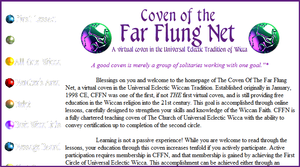- Coven of the Far Flung Net
-
Coven of the Far Flung Net 
Website Logostyle Location Wholly Online

Information Type Teaching Coven Religious affiliation(s) Wicca Denomination Universal Eclectic Wicca Tradition Established 1998 Founder Kaatryn MacMorgan-Douglas Age 18+ Classes offered 1st & 2nd Circles of UEW Medium of language English Slogan "There is no learning without dissent" School fees No fees Tuition Distance Learning Website http://www.thefarflung.net 
Screenshot of the Coven of the Far Flung Net website in April 2001 As archived on the Internet Archive Coven of the Far Flung Net (CFFN), is a virtual school which was one of the earliest Internet covens.[1] A wholly on-line teaching arm of the Church of Universal Eclectic Wicca (CUEW), it continues to offer free training in the first two degrees, or circles, of the UEW tradition. It has been described as the "best established" of the cybercovens.[2]
Contents
History
CFFN was originally established in January 1998, by Kaatryn MacMorgan; with a syllabus based upon her book All One Wicca. This was initially available as a free download, and became widely plagiarised on the internet as Book One of Wicca.[3][4]
Clan System
Initially applications to CFFN were submitted to, and screened by, MacMorgan personally: but by early 2001 CFFN had grown to the extent that this had become unwieldy, and the selection and mentoring of students was devolved to a system of clans. These were semi-autonomous sub-groups within CFFN, which accepted and reviewed applications from prospective students and provided support throughout their studies. Each clan had a distinctive character, and prospective students were directed to choose one to apply to.[5]
The first four clans within CFFN, were: Athame's Edge; Clan Willow Branch; Clan Spectra; and Sacred Moon Clan. By August 2003, this had increased to a total of seven clans: Sacred Moon Clan; Clan Willow Branch; Athame's Edge; Clan Adamant; Clan Delphi; Holy Well & Sacred Flame; and Clan Omphalos.[6]
However due to concerns about the extent to which the clans were becoming communities in their own right, MacMorgan dissolved all existing clans in December 2003.[7]
Subsequently, CFFN was restructured in early 2004, with a single entrance committee. At this time Athame's Edge hived off to form its own independent Progressive Eclectic Wicca tradition.[8]
Admissions Policy
Admission is by invitation, following submission of an admission essay in a stipulated e-mail format. The stated reason for this process is to ensure 'normative' standards of internet skills and English; and also to select applicants who are compatible with the ethos of the school.
In particular, applicants are required to state they are aged over Eighteen years, and that they accept the Affirmation of Acknowledgement. Prisoners are specifically disbarred from accessing any course CFFN offers.
Format of Study
On acceptance First Circle students are allocated a tutor, who will be their primary point of support and contact at CFFN; and who will give feedback as each lesson is submitted by email.
Each lesson is accessed from the CFFN website by entering a password, which is provided when the previous lesson has been completed to the tutor's satisfaction. Additional materials required are supplied with each lesson, but students are encouraged to read widely, both on and off line. A month is allowed for the completion of each lesson's required essay.
The First Circle co-ordinator is author and poet, Llysse Smith Wylle.
References
- ^ Cowan, Douglas E (2005). Cyberhenge: Modern pagans on the internet. London & New York: Routledge. pp. 106. ISBN 978-0-41596910-9.
- ^ Sullivan, Tammy (2005). "Cybercovens". In Llewellyn Publications. 2005 Wicca Almanac. St. Paul, MN: Llewellyn. p. 230. ISBN 0738703087.
- ^ MacMorgan, Kaatryn (2001). All One Wicca: A study in the universal eclectic tradition of wicca. Bloomington, IN: Authorhouse. ISBN 978-0-59520273-7.
- ^ MacMorgan-Douglas, Kaatryn (2007). All One Wicca: A study in the universal eclectic tradition of wicca. (Tenth Anniversary Edition ed.). Buffalo, NY: Covenstead Press. ISBN 978-0-61515094-9.
- ^ Cowan, Douglas E (2005). Cyberhenge: Modern pagans on the internet. London & New York: Routledge. pp. 107. ISBN 978-0-41596910-9.
- ^ MacMorgan, Kaatryn (2003-08-25). "Clans". Coven of the Far Flung Net. Archived from the original on 2003-05-01. http://web.archive.org/web/20030501161256/http://home.att.net/~ladykaat/coven/clans.html. Retrieved 2008-10-17.
- ^ Silverlotus (2003-12-29). "All good things...". Reflections in the Pond: Thoughts about life from a cold Canadian Wiccan. http://lotuspond.silentblue.net/blog/?p=124. Retrieved 2009-09-19.
- ^ Athame's Edge Learning Coven. "About Us". http://www.athamesedge.com/index.php?pg=4. Retrieved 2008-10-17.
Categories:- Online schools
- Distance education institutions
- Wiccan covens
- Religious organizations established in 1998
Wikimedia Foundation. 2010.

